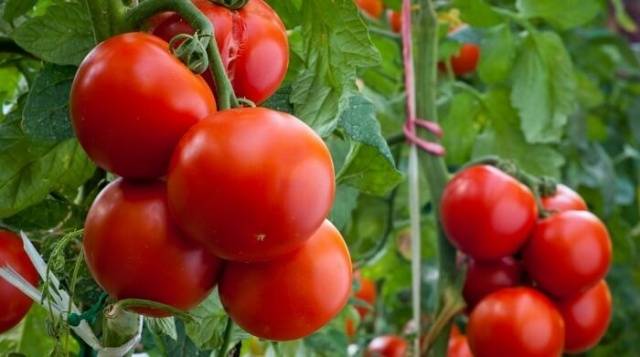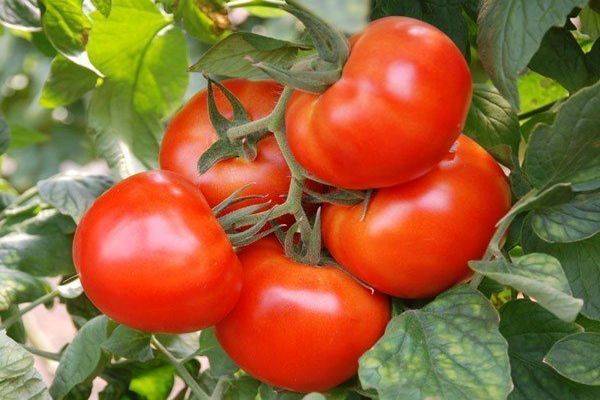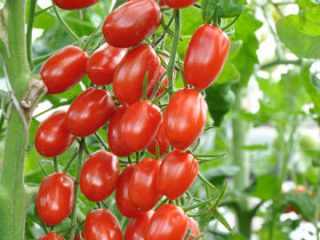Content
The Kostroma tomato is a hybrid species that is of interest to many farmers and gardening enthusiasts. The variety is used for personal needs, as well as for large enterprises. The taste of tomatoes is excellent, they can be used for different purposes, so the species is considered universal. They are early ripening and have good visual characteristics. Before growing, it is recommended to learn in detail the characteristics and description of the Kostroma tomato variety.
Description
The plant belongs to the semi-determinate type, rather tall bushes that grow up to 2 meters. This height is achieved if seedlings are planted in a greenhouse or shelters under film.
As reviews show, the Kostroma F1 tomato is not recommended for planting in open ground, as it gives poor results. The ripening period is quite early; from the moment the seeds are planted to the start of the first harvest, an average of 105 days pass. The bushes have many leaves of a standard shape for vegetables, green in color.
This variety is perfect for gardeners who cannot always be at the dacha. The Kostroma f1 tomato does not require much effort to care for and is much easier to grow than indents.
A height of 2 meters is optimal for any greenhouse. From 1 sq. m. it is possible to collect up to 20 kg of tomatoes.Thus, one bush will bring a harvest of 5 kg. The plant is maintained in one stem, with timely removal of the stepsons.
The advantage of the Kostroma tomato variety is the small number of stepsons. Therefore, even when visiting a summer cottage only on weekends, the bushes will not be densely overgrown. To maintain the desired shape of the plant, the stepsons are removed once a week.
There is no need to plant the variety too thickly. The manufacturer advises placing plants with a distance of 40 cm in a row, and 60 cm between them. This planting provides enough light for the bushes, and the soil is not depleted, which allows the tomatoes to receive the required amount of useful nutrients. In addition, the distance between the bushes will make it possible to properly care for them; the likelihood of diseases is reduced, especially with the end of summer, when the temperature fluctuates and there may be fungus.
In the video you can view different varieties of tomatoes that can be grown using the greenhouse method, including Kostroma:
Advantages and disadvantages
Among the advantages of Kostroma tomatoes are the following:
- Excellent yield.
- Early maturation.
- Good transportability, while maintaining commercial qualities.
- Excellent immunity to many diseases and pests.
- Possibility of fruit appearance even during unstable temperatures.
- The tomato is not exposed to low humidity.
The variety has much fewer disadvantages, including:
- The need for the construction and use of film shelters and greenhouses for growing.
- The need to shape the plant using trellises.
- To prevent brush breaks, they need to be tied up in a timely manner.
As you can see, the description of the Kostroma tomato has more positive aspects than negative ones.
Fruit characteristics
The fruits are flat-round in shape, with a smooth structure. Their color is very bright, rich, red. The average weight of one tomato is 110 grams, the minimum indicators are fruits weighing 85 grams, and the maximum weight reaches 150 grams.
On the bushes, the fruits are collected in a cluster, on which up to 9 pieces appear. The taste is dessert, which means it is ideal for salads and fresh consumption. Kostroma is good in sauces and ideal for pickling. If planted on 1 sq. m. 3 bushes, then during harvest, each plant will bear 5 kg of tomatoes. The peel and shape are not damaged during transportation.
The formation of brushes is carried out in the 9-10 sinuses, and then appear in every second. After forming 10 brushes, it is recommended to pinch the crown. The pulp of the variety is quite dense, as is the peel itself.
Instead of a review about the Kostroma tomato, it’s better to look at the photo:
Seedling
Preparation of seedlings should begin based on the need for harvesting. If you want to get early tomatoes, then the seeds need to be planted in early spring (March). Just in April the seedlings will be ready for further transplantation.
Transplantation of seedling material should be carried out when the soil in the greenhouse warms up to a stable 13 degrees. For the northern region, it will take longer for the earth to warm up, which means seedlings are prepared later. It is recommended to sow the seeds in April and plant them in May.
To get good seedlings you need to use the following rules:
- Prepare the soil. For this, soil from the garden bed, peat and compost are used.A week before planting the seeds, you need to treat the soil with a solution of potassium permanganate, and water it with water the day before.
- All seeds undergo calibration; they must be placed in a solution of potassium permanganate for a quarter of an hour and dried.
- Place the finished raw materials on moist soil, with a distance of 4 square meters. cm. Next, 2 layers of earth are poured, and the container is covered with glass or film and left warm.
- When the first shoots appear, it is necessary to remove the film or other materials.
- During the formation of the first pair of leaves, picking is carried out. The seedlings are transplanted into separate containers; you can use disposable cups or special containers.
40 days after planting, the seedlings should be ready for further action. It can be planted in a greenhouse; the sooner the summer resident does this, the faster the harvest will be.
Growing rules
After planting seedlings, you need to know some more rules to get a high-quality harvest. First you need to wait for growth and begin to form bushes. As experienced farmers say, formation is best done on a vertical trellis. Be sure to tie the brushes so that they do not break off.
After the 5th cluster appears, you need to start removing leaves, about 2-4 pieces from the bottom of the plant. This procedure should be carried out weekly to improve soil aeration and also enhance the nutrition of tomatoes with useful substances.
When up to 10 clusters are formed, it is necessary to limit the growth of the bushes. To do this, the central shoot is pinched. It is important to leave a couple of leaves above the last brush.
Kostroma has good immunity and is not afraid of many tomato diseases.Therefore, the harvest can be obtained even at unstable temperatures and other negative factors. Further care consists only of loosening the soil and watering using warm water. By the way, the hybrid loves watering after sunset. Additionally, they are promptly removed weeds, feeding is carried out throughout the growth and formation of the bush.
Considering the description of Kostroma tomatoes, their versatility, and productivity, many people use the seeds as an annual planting variety.
Storage and collection
For storage, it is recommended to use tomatoes that have not been frozen, otherwise they will begin to deteriorate. The collection itself is carried out based on maturity, but it is recommended to collect them in August-September. It is best to choose weather without precipitation for this.
It is best to select tomatoes without damage, which will be dense, this will allow them to be preserved for a long time. They are placed in wooden boxes, covered with paper, and each layer of tomatoes is sprinkled with sawdust. After this, the container is lowered into the cellar, the humidity of which is no more than 75% and there is ventilation.
Diseases
As already noted, Kostroma’s immune system is strong, tomatoes are not afraid of many diseases. The variety that resists best is:
- Tobacco mosaic virus.
- Cladosporiosis.
- Fusarium.
Despite strong immunity, general preventive measures will not harm the plant.
Reviews
Conclusion
There is no need to doubt about planting the Kostroma variety. If the summer cottage is equipped with a greenhouse, then the choice will be justified. The main advantage is minimal care requirements and maximum productivity.











